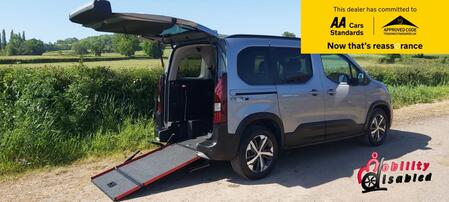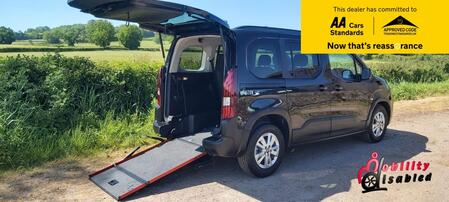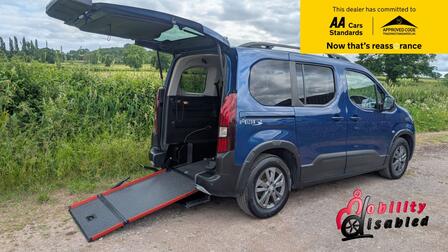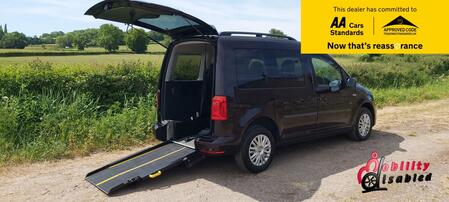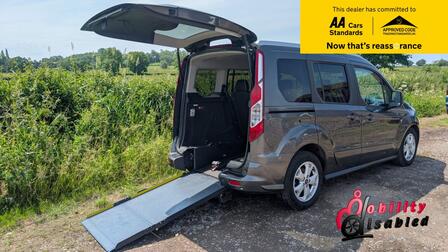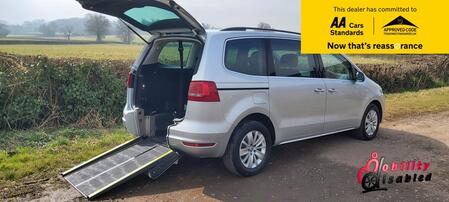
Lowered floor wheelchair vehicles, also known as wheelchair accessible vehicles (WAVs), are vehicles that have been adapted to accommodate people who use wheelchairs. These vehicles typically have a lowered floor with a ramp (whether that be manual or automated) and a securing system for the wheelchair and its user. While a lowered floor wheelchair-accessible vehicle (or WAV) will provide many benefits and they may offer increased accessibility for individuals with mobility challenges, they also need certain considerations:
1. Ground Clearance & Angles: Lowered floors can reduce the ground clearance of a wheelchair vehicle. This may lead to potential issues when driving over uneven terrain, speed bumps, or navigating through areas with poor road conditions. Care must be taken when ground clearance is compromised in your wheelchair vehicle. The lowered floor alters the entry and exit angles of the vehicle so be carefully to avoid scraping the undercarriage, especially when navigating driveways or ramps.
2. Limited Seating Capacity: The modifications and adaptions required to create a lowered floor wheelchair vehicle can often result in a reduced seating capacity. This limitation can be a concern for larger families or groups.
3. Cost of Modifications: Converting a vehicle to have a lowered floor can be an expensive process. This cost may include structural modifications, ramps, and other accessibility features as requested by the purchaser to create a wheelchair vehicle.
4. Increased risk of weather damage: In regions with harsh weather conditions, such as heavy snowfall, lowered floor vehicles may face challenges. As lowered floor wheelchair vehicles are more susceptible to water damage due to a lower ground clearance. Accumulated snow or ice can impede the functioning of ramps or make entry and exit difficult or if the wheelchair vehicle is driven through floods or it is an excessively rainy day.
5. Increased risk of entry and egress accidents: Entry and egress, the process of getting in and out of the vehicle, can be more difficult and hazardous in lowered floor wheelchair vehicles. Although all ramps are fitted with a non-slip surface for this very reason care should still be taken in wet and icy weather. Before loading the wheelchair into the vehicle attach the winch or electric front belts to added security.
6. Maintenance Challenges: Lowered floor and wheelchair vehicle modifications may require more maintenance than standard vehicles. This is because the ramp, the securing system, and the lowered floor itself can be prone to wear and tear.
7. Increased risk of theft: Valuables are generally more visible in lowered floor wheelchair vehicles as there isn’t the boot space for storage which would be out of sight. This can make them more vulnerable to theft.
8. Ramp Space Requirements: Deployable ramps require additional space around the wheelchair vehicle for operation. This may be a consideration when parking in tight spaces or in areas with limited clearance.
9. Limited Vehicle Choices: The availability of vehicles with lowered floors is more limited compared to standard models. This can restrict the options for individuals seeking specific features or models.
While lowered floor wheelchair vehicles greatly improve accessibility, individuals and carers should carefully weigh the benefits against these potential challenges and choose a vehicle that aligns with their specific needs and lifestyle. Regular maintenance and awareness of the wheelchair vehicles limitations are essential for a safe and reliable driving experience.
While lowered floor wheelchair vehicles provide many benefits, it is important to be aware of the potential perils. By following the tips in this article, you can help to reduce the risk of accidents and damage to the vehicle.
Customer Reviews
Excellent communication service and product.Highly recommend this company to anyone seeking a wheelchair adapted vehicle... Read More
Laurie Gascoigne
They are very pleasant, courteous and helpful. Circumstances meant we had to buy a WAV quickly and they helped in aiding this process without sales pr... Read More
Charlotte Hall
First class, friendly service. The garage offers a huge range of vehicles on the premises and the owners were happy to spend time explaining the featu... Read More
Ivor Isaac
very helpful, bought a Citron Berlingo adapted for my wheelchair and so far very happy with it. Also was sent some beautiful flowers as a thank you �... Read More
Kate Rees
Hi thanks very much for the gift you sent it means a lot to us and thanks for being patient and caring love the car and is preforming very good and th... Read More
Alan Ford
Very friendly and helpful team, with helpful advise. Show and guide on the different features so you can compare, and ensure they meet your needs. Off... Read More
H H
Excellent service from Peter and Clare. Peter bought the car to my home address in Bournemouth! He was well informed, calm and non pushy, allowing ple... Read More
Miss Brahms
Can’t speak highly enough of Kington Garage. Apart from the vehicle which is perfect for my Mum & Dad, the welcome we got along with the service was... Read More
Nick Greenway
Thank you so much for the proactive, responsive and supportive way you handled our viewings and sale. A very smooth and professional process throughou... Read More
Amjad Darr
Fantastic company family run buisness easy to deal with and excellent vehicle our vehicle come with a 12 month warranty with no additional charge wow!... Read More
John Smith
Contact Details
Kington GarageKington Lane
Kington
Thornbury
Bristol
BS35 1NH 0333 200 8593 (local rate charges) 07305 049 640 sales@mobilitydisabled.co.uk

 Wheelchair CITROEN
Wheelchair CITROEN Wheelchair FIAT
Wheelchair FIAT Wheelchair FORD
Wheelchair FORD Wheelchair PEUGEOT
Wheelchair PEUGEOT Wheelchair VOLKSWAGEN
Wheelchair VOLKSWAGEN